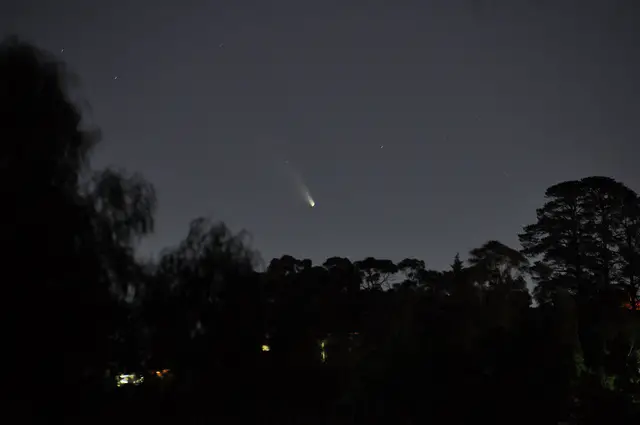Comets appear to be like a faint band of light which looks larger and brighter than any other objects in the sky, especially during the night. Many comets tend to have a tail along with a bright star like appearance.
Some comets glow like a big round ball of fire. They move quite slowly and sluggishly. Comets move around the sun in their respective orbits, just like any other planets. Here are some more interesting things to know about Comets.
-
A comet has primarily three distinct parts- the head, the tail and the nucleus. The core or nucleus is believed to be the actual comet, which is formed of a lumpy solid that can extend up to several kilometers in length.
-
The head of any comet is quite large and appears like a smudged cloud which surrounds the nucleus. This is the reason why the comet appears distinct and bright. The tail is a glowing band of light made up of waste and wispy products which are formed near the head and travels down slowly when the comet is in motion.
-
The very first comet observation study was proposed by the Dutch astronomer Tycho Brahe in 1577. He concluded that the comets can never enter the Earth’s atmosphere; they only appear around the Earth following a particular time period.
-
Therefore, it was evident that the comets exist far from the atmospheric proximity of the Earth. The composition of a comet may range from dusty rock particles to ice crystals that were debris long back during the initiation of the solar system, 4.5 billion years past.
-
Comets are the remaining waste of cold and dry parts of the solar system. They are thought to have originated from two sources- The Kuiper Belt and the Oort cloud.
-
The orbit of a comet is elliptical in shape which is why it comes closer to the sun and goes far off again. Short term comets orbit the sun in an average of every twenty years or even less while long term comets go round the sun in every 200 years or even more.
-
The tail of a comet is only visible because of the reflection of sun rays through the coma and dust. Some molecules in the tail are excited by the energy from the sun, so they tend to glow to make an ionic-tail, bluish in colour. Neutron-sodium atoms form a yellow tail too.
-
Scientists have recorded the size of comets from less than a kilometer in diameter to as long as 300 kilometers or even more. The latter is known as Chiron, which is unable to travel into the innermost layers of the solar system.
-
The comet study is very important with respect to Earth, as the nature of a comet can determine whether it would collide with the Earth and accordingly better protection methods can be predicted out.
-
The nucleus of a comet is sometimes provided with a dark and mottled front face, but it is unknown whether it is layered from within. The inside structure of a comet is still not known. Still scientists are coming up with innovative missions like Deep Impact to solve such mysteries.
Sir Isaac Newton had concluded about comets saying that they are celestial travellers or wanderers whose motion is accelerated by the gravitational pull of the Sun. The orbit of a comet is parabolic and might have an orbital time period of about a year to several hundred years.











Leave a Reply